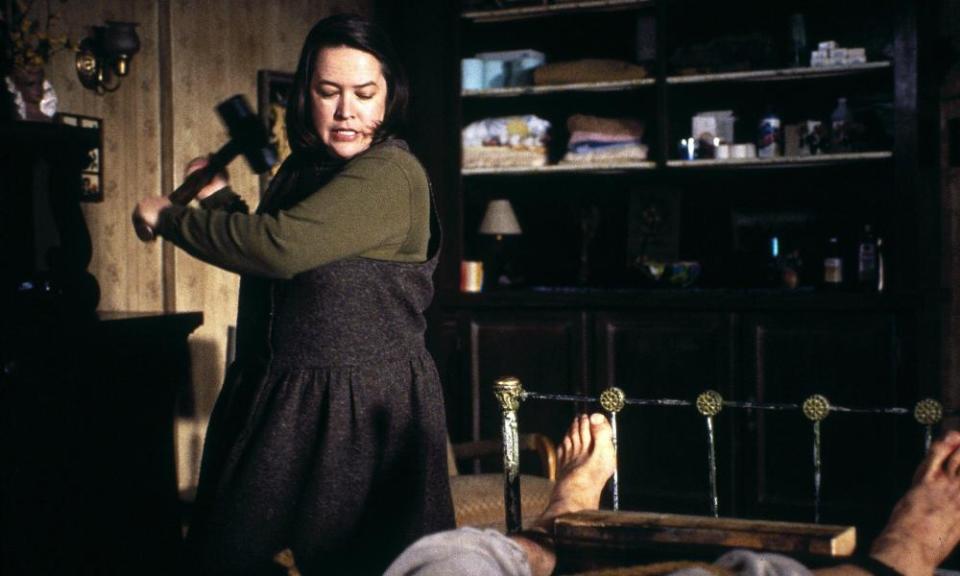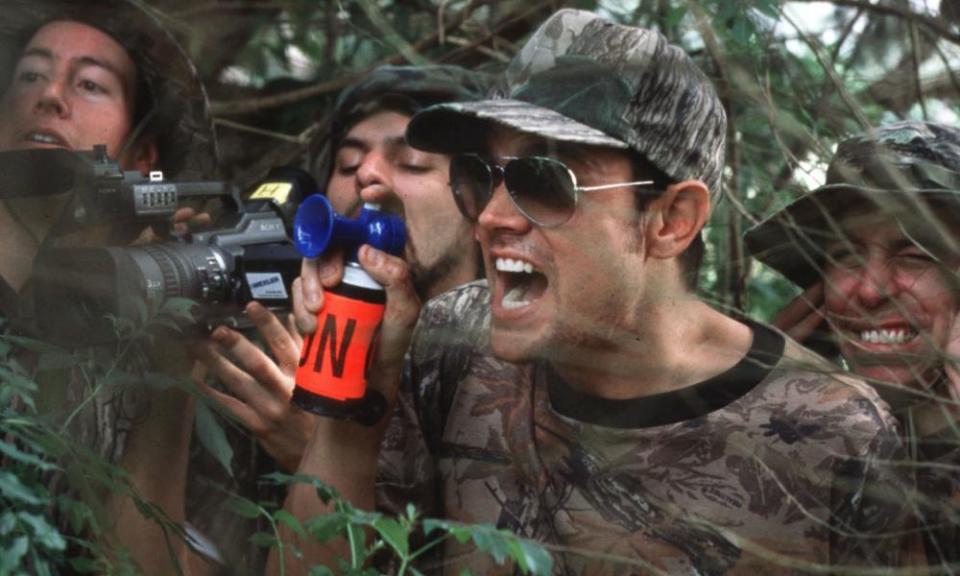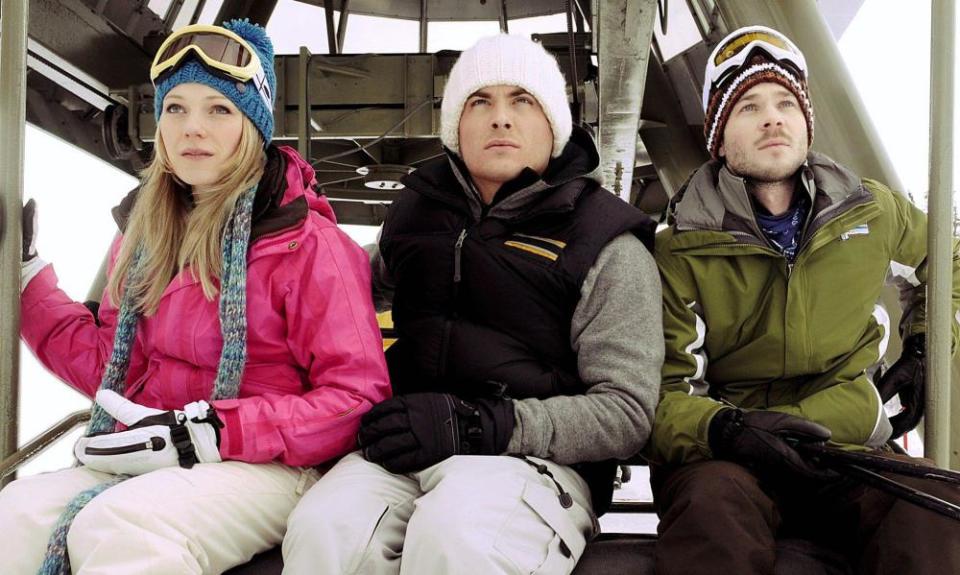‘Truly unwatchable’: writers on their toughest scenes of movie violence
- Oops!Something went wrong.Please try again later.
- Oops!Something went wrong.Please try again later.
- Oops!Something went wrong.Please try again later.
- Oops!Something went wrong.Please try again later.
- Oops!Something went wrong.Please try again later.
- Oops!Something went wrong.Please try again later.
- Oops!Something went wrong.Please try again later.
The club – Irréversible
A rape-revenge thriller told in reverse, Gaspar Noé’s infamous provocation opens with the revenge part first, as two men (Vincent Cassel and Albert Dupontel) embark on a frantic search for the monster who sexually assaulted and mutilated the woman (Monica Bellucci) at the center of their lives. As they descend into a BDSM club called The Rectum, Noé levels his own kind of assault on the audience, with the camera swirling relentlessly down this chaotic inferno and the soundtrack enforcing a feeling of deep disorientation, like a carnival ride due for decommission. When one of the men finally identifies their target – falsely, as it happens – he pulverizes his face with a fire extinguisher, the camera following every swing. Irréversible will later stage the rape through one long, pitilessly static take, but this sequence is a blow to the solar plexus, and we never fully recover from it. Scott Tobias
The hobbling – Misery

There will always be certain types of movie violence that make me wince regardless of context (fingernail damage, protruding bones, Ewan McGregor’s American accent) but it often takes an added level of emotional involvement to really sear an act of brutality into my brain. In Rob Reiner’s exquisite adaptation of Stephen King’s thriller Misery, the infamous hobbling scene arrives deep into a carefully escalated two-hander between characters we have grown to believe and understand: an obsessive fan and the object of her obsession, both written and performed with depth and sensitivity. Scored by Beethoven’s Moonlight Sonata (a cruel, devastating pick), the impact of a hammer to the legs is shocking for its obvious visceral nastiness (even though Reiner chooses restraint in how much we get to see) but also for what it means at a deeper character level. It’s tragic both for a strangely humanised antagonist’s unstoppable descent into madness and for the hopelessness it forces upon her victim, a shocking act that takes a toll on everyone, including us. Benjamin Lee
The paper cuts – Jackass: The Movie

I generally find violence in movies to be a goofy good time for the fact of its fakery, the gravity of the gristle onscreen undermined by my knowledge of the messy fun involved in its staging. For this reason, the only thing that wields the power to make me tense up with phantom sympathy pain is Jackass, wherein the pounds of flesh paid for our sick amusement have a real weight to them. As Johnny Knoxville submits to paper cuts between his fingers and toes, only to be one-upped by Steve-O slicing the crease of his lips, we all become cameraman Lance Bangs, repressing his vomit reflex so hard he passes out. In the comment section of the YouTube clip, many users describe a similarly intense vicarious reaction. Something about the sensitivity in these delicate flaps of skin puts this segment a wince-worthy gash above the rest of a series that traded in true torment, its agony so acute that it collapses the distance between spectator and participant. Charles Bramesco
The Achilles’ heel – Hostel
One of the main reasons I don’t watch horror movies anymore is because of Hostel. The film is a gore-fest across the board, which I can usually suspend my disbelief enough to get past. It’s all just makeup and corn syrup, right? BUT, in this 2005 mess of a cinematic journey, there’s a scene that involves the character Josh’s heels being sliced and I still – nearly 18 years later – have not gotten over it. The moment takes place in a dungeon-esque room and sees Josh, an American on a vacation from hell with friends in Europe, bound in a chair by his Dutch businessman captor, who – among other elements of torture – cuts into Josh’s Achilles tendons. The move results in Josh’s heels literally splitting open when he attempts to get up and escape. Needless to say, he does not escape and it does not end well for him. The mere thought of the moment makes me want to touch the back of my own ankles to ensure that they’re okay. Jenna Amatulli
The sexual assault – Last Tango in Paris
The infamous rape scene in the 1972 film Last Tango in Paris is something that continued to haunt the lives and careers of actress Maria Schneider and director Bernardo Bertolucci right up until their deaths. As late as 2007, Schneider recalled the feeling that she, as a 19-year-old, felt coerced, humiliated, and violated by the much older Bertolucci. For his own part, Bertolucci would continue to rationalize and otherwise answer for what he did to his young star for the rest of his life. On its own terms, Last Tango’s rape scene is extremely difficult to watch, as it involves a 48-year-old man violating a very young woman with butter as a lubricant; but knowing the history of this scene and the life-altering impacts that it had on Schneider makes it truly unwatchable. Some things just shouldn’t be done or filmed, and this, in my opinion, is one of them. Veronica Esposito
The night stick – The Silence of the Lambs
There’s all manner of elaborate and unsettling violence in The Silence of the Lambs, including but not limited to victims being skinned alive. But the violence that always lands in the pit of my stomach is perhaps the most basic and common. During his harrowing breakout, Hannibal Lector, the cannibalistic serial killer who we’ve subsequently seen stir-frying brain tissue, wields a night stick against the police officer tasked with guarding him. This monstrous psychologist, played with frightening sophistication by Anthony Hopkins, can whisper people to death. But he goes for blunt force, raising the night stick in the air in an operatic gesture, keeping his eyes locked on the victim whose perspective we’re trapped in, and then landing every excruciatingly pulpy blow as blood sprays across his face. His breath makes a chilling wheezing sound, making the monstrous figure seem more frighteningly domestic. It’s the crude effort – and the way Lector seems to savour it – that gets right under my skin. Radheyan Simonpillai
The attack – Monster
The news gets tougher to watch by the day, so I’ve become fairly desensitized to movie violence – it’s all around us in the real world, so it takes a lot to truly get me. But when asked to pick a scene for this piece, I immediately thought of Monster, the 2003 Aileen Wuornos biopic that won Charlize Theron an Academy Award. I watched it in a darkened, black box theater during my freshman year at film school. In one relentless, unsparing scene, Wuornos – who’s not yet a serial killer, just a hitchhiking sex worker – picks up a john. They drive out to a remote spot deep in the Florida woods, where he ties her to the car door and brutally rapes her. Even just describing it makes me upset: Wuornos is bound, mercilessly beaten and sodomized with an object. That would be intense under any circumstances, but her attacker’s eerie, everyday calm as he commits such a heinous act feels especially chilling. The torture only ends when Wuornos frees herself and shoots the man; he becomes the first person she kills. The violence may be severe, but the scene doesn’t come off as gratuitous, thanks to director Patty Jenkins’ handling of the moment, which must be shown to justify Wuornos’ crime spree. Still, after watching the film once 10 years ago, I haven’t been able to again since. I don’t think I could sit through that scene one more time. Alaina Demopoulos
The brain-sucking - Starship Troopers
There’s a distinction to be made between fictional film violence and that springing from real-life; the latter, done effectively, is infinitely more distressing: Son of Saul, say, or Zodiac. Fictional violence, though no less potentially horrible, is insulated by the sheen of unreality, and so can offer the spectacle of gruesomeness to occasional advantage. Though a confirmed slasher/gore disliker, I’ve always had a lot of time for Starship Troopers and its particularly glutinous approach to the sci-fi creature feature; director Paul Verhoeven has a unique way of filming incredibly revolting scenes in a way that deflects their impact without concealing their nastiness (“It’s an ugly planet, a Bug planet! A planet hostile to life as we know - AAAAAAGGGHHHHH!!”). It’s a fine line to tread, and Verheoven is a master of knowing where to draw it – well, until the exquisitely unpleasant moment that poor old Patrick Muldoon gets his brains sucked out by the brain bug. I’ve seen Starship Troopers scores of times, I know exactly what’s about to happen and still can’t watch it. Andrew Pulver
The head shot – The Departed
I flinch at plenty of movie violence. But I also absorb a hell of a lot of it – your Saws, your Hostels, your various slashers – so while I may wince in the moment, there isn’t a lot of violence or gore that stands out years later as exceptionally upsetting. But there’s one head shot that haunts me: the sudden death of William Costigan (Leonardo DiCaprio) in Martin Scorsese’s The Departed. Scorsese doesn’t linger on the bloody details of Costigan’s physical demise; it’s the abrupt splatter of the single shot to the head, dispatching the movie’s most sympathetic character (played by an actor giving one of his best and most intense performances) that provides such a jolt of soul-sickness. Costigan, a cop whose nerves have been frayed to their barest threads by his long-term undercover assignment, finally has his mysterious nemesis Colin Sullivan (Matt Damon), the upstanding-looking cop informing his mob bosses on police activity, in cuffs, ready to finally end his personal hell. He drags Sullivan into an elevator, and when the doors open, another mob-owned cop shoots him dead without hesitation. There’s just something so deeply sad about reducing Costigan’s emotional struggle to a smear of blood on the wall of an elevator – and unlike so many shocks of movie violence, this one reverberates beyond the moment. When I think of The Departed, it’s hard not to think of poor Costigan losing everything in a split second. Scorsese’s crime movies may be wildly entertaining, but they leave a mark. Jesse Hassenger
The jump – Frozen

Every time I would go skiing as a kid, I would stress about the chairlift – so high, so unguarded, so pitched. What if you got stuck? And then I saw Frozen, one of two scary movies that convinced me to mostly avoid them in the years since (sorry). In Adam Green’s 2010 survival horror film, which I cannot believe premiered at Sundance, a blizzard and a miscommunication between operators causes three friends to be trapped on a chairlift for a week. I think about this situation a lot: maneuvering on a perilously high chair, hands frozen to the metal bar, skin ripped open, no food or water. Even worse is the film’s signature moment of violence: seeking help, one of the friends jumps off the chairlift, snaps both legs (bone exposed, we see it) and gets shredded apart by wolves, death cries echoing off the mountain. What a horrible way to go, what tabloid headline it would be, and what a searing indictment of chairlifts I will never forget. Adrian Horton

